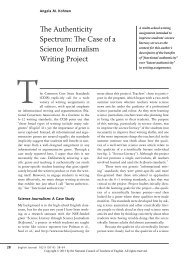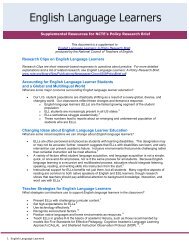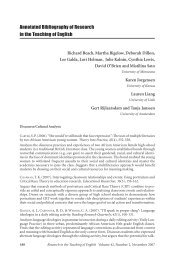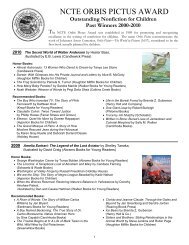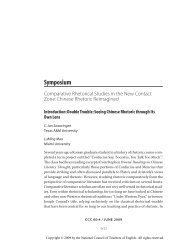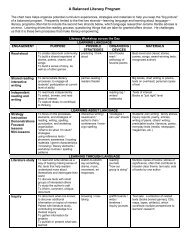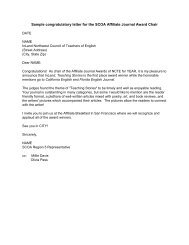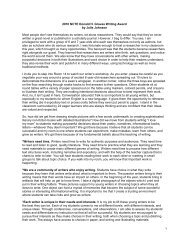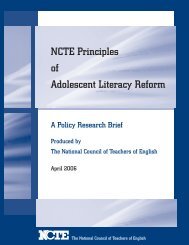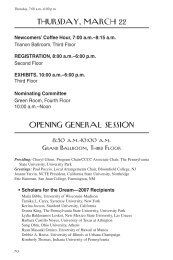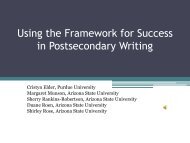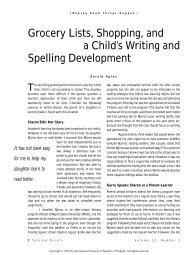Annotated Bibliography of Research in the Teaching of English
Annotated Bibliography of Research in the Teaching of English
Annotated Bibliography of Research in the Teaching of English
- No tags were found...
You also want an ePaper? Increase the reach of your titles
YUMPU automatically turns print PDFs into web optimized ePapers that Google loves.
238 <strong>Research</strong> <strong>in</strong> <strong>the</strong> Teach<strong>in</strong>g <strong>of</strong> <strong>English</strong> Volume 41 November 2006KAUFMAN, J. C., GENTILE, C. A., & BAER, J. (2005). Do gifted student writers and creative writ<strong>in</strong>gexperts rate creativity <strong>the</strong> same way? Gifted Child Quarterly, 49(3), 260-265.Exam<strong>in</strong>es how gifted high school students and experts (cognitive psychologists, creative writers,and teachers) rated 27 short stories and 28 poems for creativity. F<strong>in</strong>ds a strong degree <strong>of</strong>correlation between <strong>the</strong> rat<strong>in</strong>gs <strong>of</strong> <strong>the</strong> novices and those <strong>of</strong> <strong>the</strong> experts. Concludes that giftednovices would be able to <strong>of</strong>fer <strong>the</strong>ir peers high-quality feedback.NUSSBAUM, E. M., & KARDASH, C. M. (2005). The effects <strong>of</strong> goal <strong>in</strong>structions and text on <strong>the</strong>generation <strong>of</strong> counterarguments dur<strong>in</strong>g writ<strong>in</strong>g. Journal <strong>of</strong> Educational Psychology, 97(2), 157-169.Exam<strong>in</strong>es ways <strong>of</strong> encourag<strong>in</strong>g students to consider more counterarguments when writ<strong>in</strong>g argumentativetexts. Followed 184 college students as <strong>the</strong>y wrote essays on TV violence. In Experiment1, students who were given goal <strong>in</strong>structions generated more counterarguments andrebuttals than controls. In Experiment 2, students received persuasion goals and/or a text outl<strong>in</strong><strong>in</strong>gcounter arguments. F<strong>in</strong>ds that <strong>the</strong> text had a positive effect on <strong>the</strong> quality <strong>of</strong> arguments,while persuasion goals reduced students’ counterargumentation, mak<strong>in</strong>g <strong>the</strong>ir th<strong>in</strong>k<strong>in</strong>g onesided.Concludes that persuasion goals should be used with caution.PETERSON, S. S., & KENNEDY, K. (2006). Sixth-grade teachers’ written comments on student writ<strong>in</strong>g:Genre and gender <strong>in</strong>fluences. Written Communication, 23(1), 36-62.Exam<strong>in</strong>es <strong>the</strong> <strong>in</strong>fluence <strong>of</strong> genre and gender on comments written by 108 6th-grade teachers <strong>in</strong>response to two narrative and two persuasive texts. F<strong>in</strong>ds significant genre differences. In comment<strong>in</strong>gupon narratives, teachers emphasized process, conventions, artistic style, and format.For persuasive texts, mean<strong>in</strong>g, organization, effort, and ideology were emphasized. Teacherstended to provide more criticisms when <strong>the</strong> text was attributed to a male writer. Female teacherswrote greater numbers <strong>of</strong> comments and corrections.SCHEUER, N., DE LA CRUZ, M., POZO, J. I., HUARTE, M. F., & SOLA, G. (2006). The m<strong>in</strong>d is not a blackbox: Children’s ideas about <strong>the</strong> writ<strong>in</strong>g process. Learn<strong>in</strong>g and Instruction, 16(1), 72-85.Exam<strong>in</strong>es what children know about <strong>the</strong> writ<strong>in</strong>g process. Sixty five- to n<strong>in</strong>e-year-old childrenwere <strong>in</strong>terviewed about <strong>the</strong> content <strong>of</strong> a character’s th<strong>in</strong>k<strong>in</strong>g at four moments <strong>of</strong> <strong>the</strong> writ<strong>in</strong>gprocess; anticipat<strong>in</strong>g, writ<strong>in</strong>g, revis<strong>in</strong>g, and reread<strong>in</strong>g. F<strong>in</strong>ds a developmental change <strong>in</strong> <strong>the</strong>focus <strong>of</strong> children’s ideas about writ<strong>in</strong>g. Fourth-grade students showed an emergent concernwith rhetorical aspects <strong>of</strong> writ<strong>in</strong>g.STERNA, L. A. (2006). Effective faculty feedback: The road less traveled. Assess<strong>in</strong>g Writ<strong>in</strong>g, 11(1),22-41.Analyzes faculty comments on 598 college students’ papers. Consistent with previous research,f<strong>in</strong>ds that comments focused largely on edit<strong>in</strong>g matters with few comments address<strong>in</strong>g development<strong>of</strong> ideas or organization. Suggests that this feedback may not foster student development<strong>of</strong> ideas.VANDEWEGHE, R. (2005). What are <strong>the</strong> effects <strong>of</strong> writ<strong>in</strong>g-to-learn programs? <strong>English</strong> Journal,95(2), 97-100.Conducts a meta-analysis <strong>of</strong> 46 writ<strong>in</strong>g-to-learn studies. F<strong>in</strong>ds small but positive effects onachievement, effects that vary by degree <strong>of</strong> reflection, frequency <strong>of</strong> writ<strong>in</strong>g, and grade level. Noeffects occur with feedback to writ<strong>in</strong>g on achievement.VAN GELDEREN, A., & OOSTDAM, R. (2005). Effects <strong>of</strong> fluency tra<strong>in</strong><strong>in</strong>g on <strong>the</strong> application <strong>of</strong> l<strong>in</strong>guisticoperations <strong>in</strong> writ<strong>in</strong>g. L1 – Educational Studies <strong>in</strong> Language and Literature, 5(2), 215-240.



